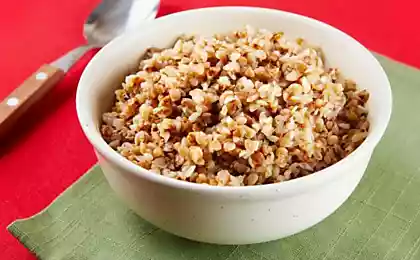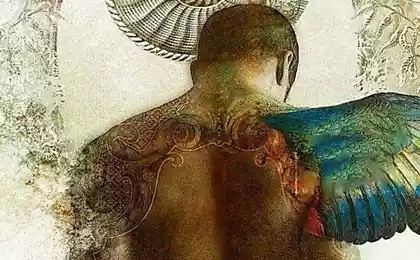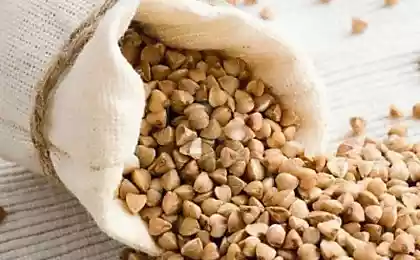461
Buckwheat thins the blood and not only

Buckwheat is not cereal crops and is not connected by kinship with the wheat. In this way the growth of seeds it is similar to cereals. It belongs to the family Polygonaceae, which also includes sorrel, rhubarb, Japanese knotweed and other plants. The scientific name of buckwheat — Fagopyrum esculentum. For centuries, buckwheat was cultivated in China and the Himalayas. She was a staple food long before it became rice and other cereals. Buckwheat contain many essential human nutrients, proteins, fats and minerals. All this provided the inhabitants of the mountains a normal diet even in such harsh terrain.
On resource Nutrition And You reported much of what science knows about crap. It is a dicotyledonous plant and is planted annually. It ripens well even in less than optimal soil conditions.
The plant reaches 40-60 cm in height and blooms pink or white flowers that attract honey bees. Her grain — pyramidal triangular, are brown or gray and have a dense shell. Nucleoli bean creamy white color and are characterized by oreopteris taste.
The benefits of buckwheat for health
Buckwheat grain contains more starch than any other grain. Their nutritional value is quite high with 343 calories per 100 grams. So they are a good source of energy. The caloric content of buckwheat grains compared with such common cereals as wheat, maize and rice, and legumes — chickpeas, Golden beans (mung) and cow peas.
The protein content in buckwheat grains is from 11 to 14 grams per 100 grams of product. Thus, buckwheat is less rich in protein than quinoa (quinoa) and legumes.
Buckwheat is very rich in digestible and indigestible fiber. In 100 grams contains 10 grams of dietary fiber, which is 26% of the daily needs of the body in it. Fiber increases the volume of food and prevents constipation, speeding up the passage of food through the digestive tract. Fiber also binds toxins and facilitates their extraction from the digestive tract. It helps to prevent the mucous membrane of the colon from cancer. Additionally, dietary fiber binds to bile salts (produced from cholesterol) and reduces re-absorption of colon. This reduces the level of serum LDL-cholesterol ("bad cholesterol").
Buckwheat is a gluten free food. Gluten — a protein found in grain. It can cause stomach upset and diarrhea in people with celiac disease.
Buckwheat contain several polyphenolic antioxidant compounds, rutin (vitamin P), tannins and catechins. From rutin (quercetin rutinoside of) was discovered anti-inflammatory and antioxidant properties. It helps to prevent the build-up of plaque in the blood vessels. In the initial stage of laboratory studies show that rutin can be used for the treatment of hemorrhoids and blood coagulation disorders.
Buckwheat also contains the minerals copper and magnesium. Copper is necessary for formation of red blood cells. Magnesium has a relaxing effect on the blood vessels leading to the brain. As it was discovered, it has a therapeutic effect for depression and headaches.
Selection and storage of buckwheat
Buckwheat sold in stores in the form of groats and flour. Preference should be given dry grains with intact husks. Covered with grain husk — brown-black, the nucleoli of these grains — whitish.
Buckwheat flour should not be stored for long periods, and use fairly quickly. It is full of oil, so over time it becomes rancid.
Store buckwheat grain, protected from air flow container in a cool and dry place. They are stored for approximately two months. Flour should be stored in the fridge, preventing air entry into the container with her.
Caution
Buckwheat grain and husk in small quantities contain polyphenolic flavonoid compound rutin (quercetin rutinoside). It was found that rutin has anti-inflammatory, antioxidant and protivodiabeticheskie (blood-thinning) properties and may interact with other medicines.\

Nutritional value of buckwheat
In parentheses are the percentage of the daily allowance. Nutritional value is based on 100 grams of buckwheat according to information from the Ministry of agriculture of the United States.
General information:
energy value — 343 kilocalories (17%);
carbohydrates — 71,50 grams (55%);
protein of 13.25 grams (24%);
fat — 3,40 grams (17%);
cholesterol — 0 milligrams (0%);
fiber, part of the food — 10 grams (26%).
Vitamins:
folate (vitamin B9) — 30 micrograms (7,5%);
nicotinic acid (vitamin B3) — to 7, 020 milligrams (44%);
Pantothenic acid — 1,233 milligrams (25%);
Riboflavin (vitamin B2) — 0.425 mg (33%);
thiamine (vitamin B1) — 0,101 milligrams (8,5%);
vitamin A — 0 international units (IU, IU) — 0%;
Electrolytes:
sodium — 1 milligram ( potassium — 460 mg (10%).
Minerals:
calcium 18 mg (2%);
copper — 1,100 milligrams (122%);
iron — 2.20 milligram (27,5%);
magnesium — 231 milligrams (58%);
Margaret — 1,300 milligrams (56,5%);
phosphorus — 347 mg (50%);
selenium — 8.3 micrograms (15%);
zinc — 2.40 milligrams (22%).
Amino acids:
lysine 672 mg (32%);
methionine — 172 milligrams (24%);
tryptophan 192 mg (69%). published
Source: hi-news.ru























